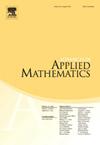Generalized Morse theory of distance functions to surfaces for persistent homology
IF 1.3
3区 数学
Q3 MATHEMATICS, APPLIED
引用次数: 0
Abstract
This paper brings together three distinct theories with the goal of quantifying shape textures with complex morphologies. Distance fields are central objects in shape representation, while topological data analysis uses algebraic topology to characterize geometric and topological patterns in shapes. The most well-known and widely applied tool from this approach is persistent homology, which tracks the evolution of topological features in a dynamic manner as a barcode. Morse theory is a framework from differential topology that studies critical points of functions on manifolds; it has been used to characterize the birth and death of persistent homology features. However, a significant limitation to Morse theory is that it cannot be readily applied to distance functions because distance functions lack smoothness, which is required in Morse theory. Our contribution to addressing this issue is two fold. First, we generalize Morse theory to Euclidean distance functions of bounded sets with smooth boundaries. We focus in particular on distance fields for shape representation and we study the persistent homology of shape textures using a sublevel set filtration induced by the signed distance function. We use transversality theory to prove that for generic embeddings of a smooth compact surface in , signed distance functions admit finitely many non-degenerate critical points. This gives rise to our second contribution, which is that shapes and textures can both now be quantified and rigorously characterized in the language of persistent homology: signed distance persistence modules of generic shapes admit a finite barcode decomposition whose birth and death points can be classified and described geometrically. We use this approach to quantify shape textures on both simulated data and real vascular data from biology.
持久同调中曲面距离函数的广义Morse理论
本文将三种不同的理论结合在一起,目的是量化具有复杂形态的形状纹理。距离场是形状表示的中心对象,而拓扑数据分析使用代数拓扑来表征形状中的几何和拓扑模式。这种方法中最著名和应用最广泛的工具是持久同源性,它以一种动态的方式跟踪拓扑特征的演变,就像条形码一样。莫尔斯理论是研究流形上函数临界点的微分拓扑框架;它已被用来表征持久性同源特征的出生和死亡。然而,莫尔斯理论的一个重要限制是它不能很容易地应用于距离函数,因为距离函数缺乏莫尔斯理论所要求的平滑性。我们对解决这一问题的贡献是双重的。首先,我们将摩尔斯理论推广到光滑边界有界集合的欧氏距离函数。我们特别关注形状表示的距离场,并使用由符号距离函数诱导的子水平集过滤来研究形状纹理的持久同源性。我们利用横向性理论证明了对于光滑紧曲面的一般嵌入,符号距离函数允许有限多个非退化临界点。这产生了我们的第二个贡献,即形状和纹理现在可以用持久同源的语言来量化和严格表征:一般形状的符号距离持久模块允许有限的条形码分解,其出生和死亡点可以被几何分类和描述。我们使用这种方法来量化模拟数据和来自生物学的真实血管数据的形状纹理。
本文章由计算机程序翻译,如有差异,请以英文原文为准。
求助全文
约1分钟内获得全文
求助全文
来源期刊

Advances in Applied Mathematics
数学-应用数学
CiteScore
2.00
自引率
9.10%
发文量
88
审稿时长
85 days
期刊介绍:
Interdisciplinary in its coverage, Advances in Applied Mathematics is dedicated to the publication of original and survey articles on rigorous methods and results in applied mathematics. The journal features articles on discrete mathematics, discrete probability theory, theoretical statistics, mathematical biology and bioinformatics, applied commutative algebra and algebraic geometry, convexity theory, experimental mathematics, theoretical computer science, and other areas.
Emphasizing papers that represent a substantial mathematical advance in their field, the journal is an excellent source of current information for mathematicians, computer scientists, applied mathematicians, physicists, statisticians, and biologists. Over the past ten years, Advances in Applied Mathematics has published research papers written by many of the foremost mathematicians of our time.
 求助内容:
求助内容: 应助结果提醒方式:
应助结果提醒方式:


